From Buckeyes to Cornhuskers with Frank, Ernie, Katie, and Elizabeth

OSCEOLA, IOWA - The road west from Cleveland led me through Oberlin. I had spent part of a summer in the late 80’s participating in a National Endowment for the Humanities seminar on Hawthorne, Stowe, and Dickinson at Oberlin College, so I revisited the dorm which had been my home while there, Baldwin Cottage, which was done in the irregular organic style of Henry Hobson Richardson. Oberlin is probably one of the most beautiful college towns anywhere with the huge community green and an eclectic mix of architecture. The Carnegie Library building here, while no longer a public library, serves as the Office of Admissions.
As I headed further west, I made one last stop in Clyde, OH, Sherwood Anderson’s childhood home, and the infamous locale for his Winesburg, Ohio. (more on that in a later entry). They certainly have gotten over the bad wrap that SA gave them as frustrated, straight-laced, sexually maladjusted humans and have found lots of ways to capitalize on this literary connection. We could even see this change of heart as a monument to American ingenuity and the entrepreneurial spirit. It’s hard to hold a grudge against a local boy especially in the face of real economic opportunity. Anderson would have loved that.
It was my intent next to head up to Ann Arbor, Michigan. I went to grad school at The University of Michigan, and I enjoyed every minute of the year I spent there. Ann Arbor is really like no other town, and while it has grown dramatically, it still has the academic electricity of a major intellectual center. I probably spent most of my time at the Harlan Hatcher Graduate Library
 and not a small amount of time at the mostly upstanding establishments on South State St. especially The Brown Jug. When I looked for the first place that I had lived which was a couple of miles north of the city near Whitmore Lake, there had been so much change that I couldn’t find the house. The pumpkin fields that I remember had become subdivisions. So Hart Crane and Sherwood Anderson aren’t alone in having the artifacts of their former lives obliterated by progress. I made a short detour through Hell, Michigan just so I could say that on this trip "I have been to Hell and back."
and not a small amount of time at the mostly upstanding establishments on South State St. especially The Brown Jug. When I looked for the first place that I had lived which was a couple of miles north of the city near Whitmore Lake, there had been so much change that I couldn’t find the house. The pumpkin fields that I remember had become subdivisions. So Hart Crane and Sherwood Anderson aren’t alone in having the artifacts of their former lives obliterated by progress. I made a short detour through Hell, Michigan just so I could say that on this trip "I have been to Hell and back."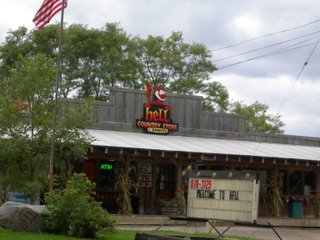
I then headed west to Chicago. Sherwood Anderson had escaped to Chicago when his marriage failed, and there, he was a key member of the group which became known as the Chicago Literary Renaissance. He was joined by Theodore Dreiser, Edgar Lee Masters, Vachel Lindsay, Harriet Monroe and others as they achieved a truly American brand of “modern” literature – realistic but often experimental and hell-bent on reflecting the steel and grit of the diverse human experience that swirled around them. While Sandburg’s house is well preserved on the North Side, and you can peer down the street (then an alley) where the infamous Dil Pickle Club met on an decidely irregular basis, there is no trace of Anderson in Chicago. He was the poor escapee from a former life and very intent on working only enough to provide support to allow him to write. The man, who had worked non-stop since he was 12, decided that his true job was writing fiction. It seems much of the physical evidence of authors is lost because so many were poor and either bunking with various friends or living in places that weren’t officially theirs and were no better than hovels anyway and thus have long since disappeared.
I couldn’t visit Chicago without a stop in Oak Park. It is one of my favorite communities in America. Any town that boasts both Ernest Hemingway and Frank Lloyd Wright as former residents certainly deserves a visit. I had a personal tour of the
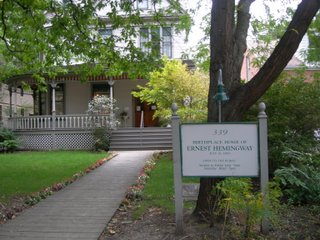 Hemingway House which shed light on his budding creativity and emphasized many of the people and institutions that were early influences on his writing. Oak Park is the true epicenter of early Frank Lloyd Wright “Prairie School” architecture. There are a total of 25 structures which include the groundbreaking house of worship- the Unity Temple and Wright’s original house and studio. It was a beautiful sunny day, so I decided that the time was now to do the architectural walking tour, but a half hour into the tour, it started to sprinkle and then pour. My safety under a huge maple tree, which I willingly shared with a couple from Buffalo, soon became no protection at all. Suddenly a teenage girl dashed out of the house that we were standing next to and invited us to wait the storm out on the porch of what was a beautiful Victorian house on Kenilworth Ave. It became clear that the deluge was not going to be short in length, So, as we waited enjoying our good fortune and dry perch, the door of the house opened and we were invited inside by the owners for tea and cinnamon rolls at the kitchen table. The house was extraordinar,y and this was an unexpected and delightful experience. I thought that perhaps the residents of this much visited city would have little tolerance or time for the hoards of tourists that constantly “walk"
Hemingway House which shed light on his budding creativity and emphasized many of the people and institutions that were early influences on his writing. Oak Park is the true epicenter of early Frank Lloyd Wright “Prairie School” architecture. There are a total of 25 structures which include the groundbreaking house of worship- the Unity Temple and Wright’s original house and studio. It was a beautiful sunny day, so I decided that the time was now to do the architectural walking tour, but a half hour into the tour, it started to sprinkle and then pour. My safety under a huge maple tree, which I willingly shared with a couple from Buffalo, soon became no protection at all. Suddenly a teenage girl dashed out of the house that we were standing next to and invited us to wait the storm out on the porch of what was a beautiful Victorian house on Kenilworth Ave. It became clear that the deluge was not going to be short in length, So, as we waited enjoying our good fortune and dry perch, the door of the house opened and we were invited inside by the owners for tea and cinnamon rolls at the kitchen table. The house was extraordinar,y and this was an unexpected and delightful experience. I thought that perhaps the residents of this much visited city would have little tolerance or time for the hoards of tourists that constantly “walk"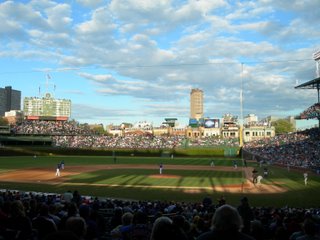 the neighborhood, but these were friendly and generous people who added a wonderful human dimension to my vision of Oak Park. It was a personal testimony to me about the inherent value of spontaneous kindness. I can’t wait to let my friend, Gayle Pumphrey know that Northern hospitality can be as wonderful and warm as the Southern variety.
the neighborhood, but these were friendly and generous people who added a wonderful human dimension to my vision of Oak Park. It was a personal testimony to me about the inherent value of spontaneous kindness. I can’t wait to let my friend, Gayle Pumphrey know that Northern hospitality can be as wonderful and warm as the Southern variety.Miraculously, the Cubs were in town for their last series. So I left Oak Park,took a CTA train and made my way to Wrigley Field, the classic neighborhood ball park. Arriving late because of rain, tea, and train delays, I was deflated to find that the Cubs were already down 8-0 at the end of the 3rd. Yet, the never-die Cubbies battled back to tie the game 9-9 in the bottom of the ninth- an astounding comeback which unfortunately turned into a tragic loss at the end of the 14th . In the end, not a good game or a good year for the Cubs, but wait ‘til next year. I left the park as they called a rain delay in the top of the 12th and met Katie Rotblat (Class of 2002) for dinner. We went to a terrific Northside neighborhood called Andersonville, ate fabulous Persian food at Reza’s ,and then made our way down Clark St to Hopleaf, a bar/restaurant which specializes in Belgian beer and food. Katie introduced me to a great Belgian brew, Vuuve, which is described as “60% barley, 40% wheat-- plus hops, coriander, and organic orange peel”- a definite winner. Katie is doing well, majoring in African American Studies and really loving being in the Windy City. We talked about life, death, parents, small towns, literature, teachers, friends, food and, of course- Foxcroft. It was a great evening, and she left me on the train as she made her way to visit Margot Hoffar , a good friend since they were freshman classmates- where else but at Foxcroft .
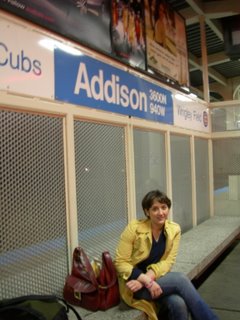
It was time to head north again and visit the place that Frank Lloud Wright called home for much of his life- Taliesen. Positioned in a lush river valley about 30 miles west of Madison, Wisconsin, Taliesen is a bold expression of Wright’s architectural ideas. The house sits perched, not at the top of the hill, but on the brow of the hill. Taliesen is Welsh for “shining brow.” Wright’s idea of architecture as a natural complement to the landscape rules supreme here. The house is kept very much the way it was when Wright died at 91 in 1959. The vistas, the angles, the function and form artfully fused create a masterful picture of a brilliant thinker and doer. This place is not a museum but a working architectural fellowship where accomplished architects, schooled in the Wright style, continue to take on apprentices who then learn the craft and, of course, add new dimensions and twists to the guiding principles of Wright and his disciples. For his last twenty years, Wright divided his time between Taliesen
 in Spring Green, Wisconsin and Taliesen West in Scottsdale, Arizona. This practice is still followed today by the members of the architectural fellowship. Taliesen is closed at the end of October, and everyone heads west to Arizona. Some say that it was not just his need in later years to have a more moderate climate in winter that brought this yearly migration, but more the coolness that his third wife always felt for Wisconsin and the emotional ties and turmoil that Wright had there which preceded her.
in Spring Green, Wisconsin and Taliesen West in Scottsdale, Arizona. This practice is still followed today by the members of the architectural fellowship. Taliesen is closed at the end of October, and everyone heads west to Arizona. Some say that it was not just his need in later years to have a more moderate climate in winter that brought this yearly migration, but more the coolness that his third wife always felt for Wisconsin and the emotional ties and turmoil that Wright had there which preceded her.Back on the road, I headed south to make my break across Iowa for Nebraska. Dubuque, IA provided an insight into modern Iowa culture. When I asked the motel clerk what people did around here, he said “Drink!,We have 20 or 30 bars on Main St..” I then rephrased my question and asked him where people worked. He said “Most of the factories have closed” so it seems that most people must work in the casinos or at the dogtrack or, I guess, in the local motels. Ah- the wonder and challenge of making ends meet in modern mid-America.
I headed south along the Mississippi River through U.S. Grant’s home, Galena, IL and then slowly down the river. The river often formed the western margin of the road, and it was wonderful to watch the boats and marvel at the soaring bridges which connected life on and next to “the” river. I was especially taken with the town of “Savanna” which sits right on the river, just a few miles south of the Mississippi Palisades, a true natural wonder.
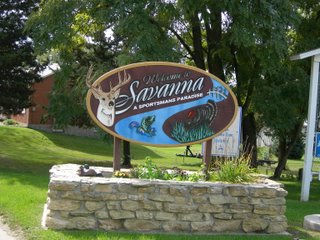
My destination before I shot across Iowa toward the wide expanses of Nebraska was Galesburg, IL and a visit with Elizabeth Waters (Class of 2006) at Knox College.
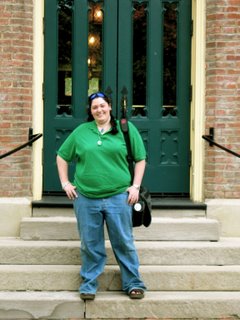 I met Elizabeth, after her Japanese class, and we enjoyed a snack at the GIZMO which is the student snack bar and gathering place. I was pleased to confirm that she loves Knox College and is looking forward to four fabulous years studying creative writing and Japanese and making lots of new friends. She has temporarily replaced choir with fencing, but we know that there will always be music in her life. She took me to see the room in Old Main where one of the famous Lincoln-Douglas debates took place in 1858 (Thus the picture of me sitting in Lincoln’s chair) and, of course, we had to visit the library. She sent me on my way “West” with the assurance that her new life at this great midwestern liberal arts college was “Excellent.!” Go Elizabeth! Little did I know that the route that I would have to take through the rest of Illinois would be the “Ronald Reagan Trail.” For those who know me, this is not a path that I have ever been tempted to follow, and the only advantage is that,I think, I probably went just a tad faster and veered a little to the left on my way to zip back across the Mississippi River into Iowa.
I met Elizabeth, after her Japanese class, and we enjoyed a snack at the GIZMO which is the student snack bar and gathering place. I was pleased to confirm that she loves Knox College and is looking forward to four fabulous years studying creative writing and Japanese and making lots of new friends. She has temporarily replaced choir with fencing, but we know that there will always be music in her life. She took me to see the room in Old Main where one of the famous Lincoln-Douglas debates took place in 1858 (Thus the picture of me sitting in Lincoln’s chair) and, of course, we had to visit the library. She sent me on my way “West” with the assurance that her new life at this great midwestern liberal arts college was “Excellent.!” Go Elizabeth! Little did I know that the route that I would have to take through the rest of Illinois would be the “Ronald Reagan Trail.” For those who know me, this is not a path that I have ever been tempted to follow, and the only advantage is that,I think, I probably went just a tad faster and veered a little to the left on my way to zip back across the Mississippi River into Iowa. If this is Iowa, can Nebraska be far away?
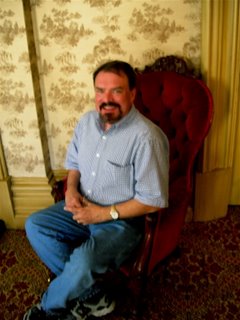

1 Comments:
It is odd that people are so desperate to make a couple of bucks that they have to invade absolutely every crevice of the internet with advertising. I almost don't even see it. Just another billboard to ignore on the road of life. Helps to improve the concentration. I have been passing through so many small midwest and plains towns. Many of them -in fact, most of them have shrunk. Some are facing extinction. The downtown areas are sometimes virtually devoid of businesses. The businesses that are there have very limited hours. I notice many old farmers in pick-up trucks coming to town to get the mail. No advertisers are vying for these markets. One town that I stopped in in western Iowa (Stanton) was trying to turn around its fortunes by emphasizing its Swedish Heritage. When I stopped in a shop which happened to be open, they featured postcards of Mrs. Olsen (who used to flog Folger's Coffee) because she was the towns most famous citizen. The sense of home and the fear of losing the place where you have lived your life makes all of these disappearing acts all the more poignant. It is almost like facing death twice- not only your own but that of all of the things that you have loved and that comprise your indelible context. I love being on the road and just as Gabriel said, you see so much when you stray away from your comfort zone. I'm beginning to feel like that famous giant "eyeball." So, yes, night is time to pull back, hunker down and veg. But the road calls again, and I am revved to go....
Post a Comment
<< Home